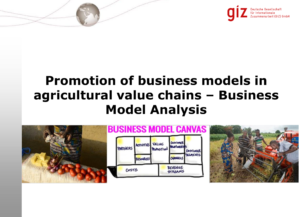Business Model Analysis as a Critical Factor for Value Chain Development
The fourth webinar sequel focuses on the analysis of business models in agricultural value chains
Presenters
Andreas Springer-Heinze, Senior Planning Officer at GIZ, and Alfons Eiligmann, ValueLinks master trainer explain the relevance of business model analysis along the agricultural value chain and introduced the business model canvas.
Jens Windel, technical advisor for the global program Promotion of Agricultural Finance for Agri-based Enterprises in Rural Areas at GIZ, presents a newly designed business model calculation tool.
Fabian Zegowitz, planning officer at GIZ, shars his experience with conducting a business model analysis in Benin.
Proceedings
During the first part of the webinar, Andreas Springer-Heinze and Alfons Eiligmann describe how every value chain consists of interlinked business models and how the business model analysis should be used to enhance value chain development. The business model canvas is included in the new ValueLinks 2.0 which helps visualizing the core of every business model and its position along the value chain.
The business model analysis also includes critical financial parameters, such as production volumes, inputs or technical efficiency ratios. They determine how profitable a current business model is or could become. The analysis is a tremendous help for identifying sustainable, successful, and replicable business models and in comparing them with each other. Furthermore, it can serve as a useful tool to verify whether a suggested value chain solution is financially attractive. Challenges of the business model approach are, among others, the limited replicability of interesting business models due to a limited market demand and unintended negative side effect for pioneers or competing companies.
The business model calculation tool
Jens Windel’s presentation shows an exemplary business model analysis, which is used to promote agricultural finance for agri-based enterprises. He illustrates the six different steps of the business model analysis — from the value chain scoping to the pilot and rollout. The calculation tool helps to determine whether a business model is profitable and lays the ground for the development of the business case.
Experiences from Benin
Fabian Zegowitz speaks of his experience in Benin where a business model analysis was conducted for cashew tree nurseries. By using the business model calculation tool, the current business models of the cashew tree nurseries were analyzed and compared with more profitable business models. As a result, farmers were encouraged to ask for loans and the willingness of MFIs to finance these improved business models increased. Fabian Zegowitz highlights the advantages of the business model approach thanks to the possibility to compare a current with an improved business model. He points out that the business model has to be continuously adapted to the value chain actors.
Join the next session!
The next webinar is scheduled for 30 May, where the topic farmer organizations will be covered. For details on each upcoming webinar, please view the web calendar. We post the details as soon they are scheduled and available.
The webinar series is conducted together with the sector project Agricultural Trade and Value Chains, the SNRD Africa working group on Agribusiness and Inclusive Value Chain Development and the GIZ Sectoral Department (FMB).
Contacts
Sector project Agricultural Trade and Value Chains Karina.Brenneis@giz.de
SNRD working group Agribusiness and Inclusive Value Chain Development tandem partner Eberhard.Krain@giz.de


